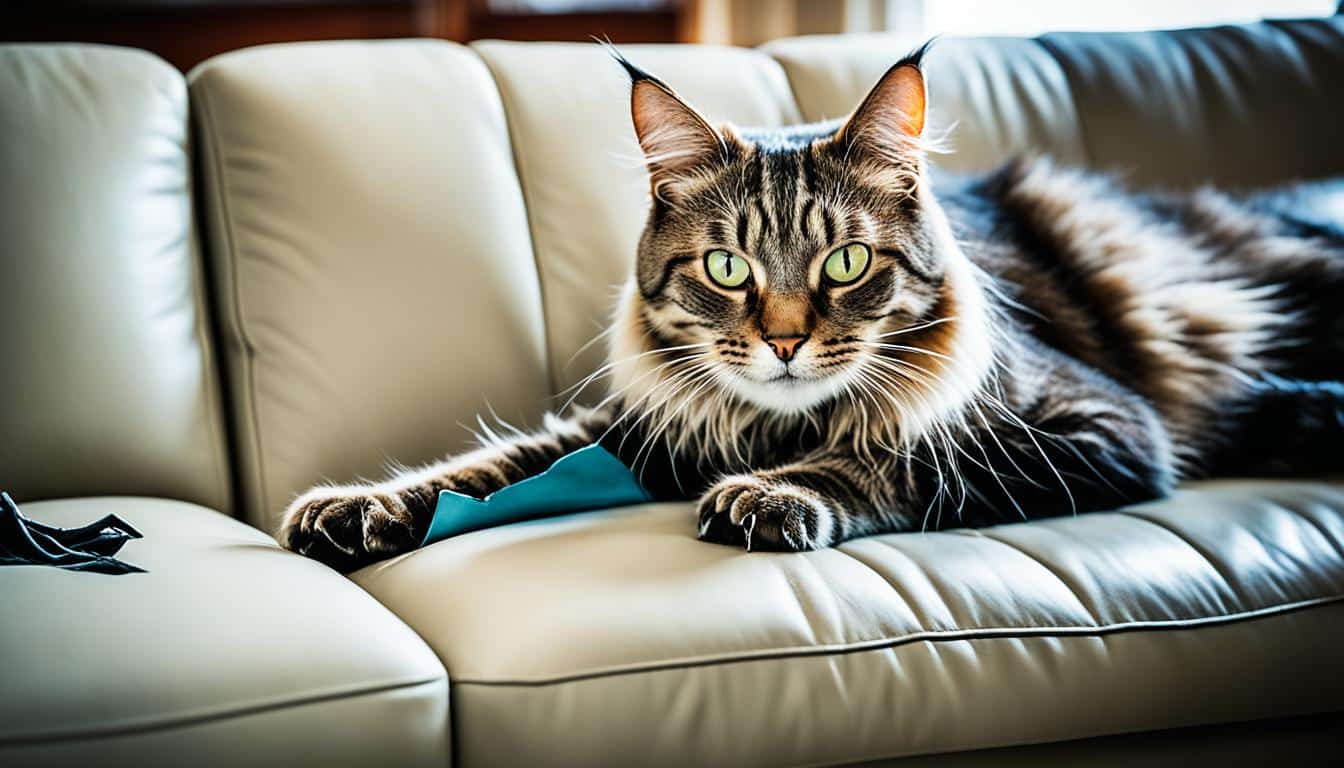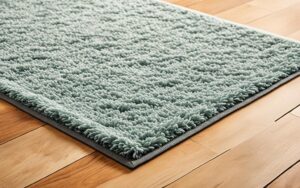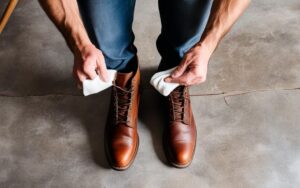Did you know that cats have retractable claws to help them hunt, climb, and defend themselves? These sharp, pointed nails can wreak havoc on your beloved leather couch, leaving unsightly scratches and tears.
But don’t worry, there are proven strategies to protect your leather couch from cats and keep it looking pristine for years to come.
As a pet owner, it’s important to create a cat-friendly environment while safeguarding your furniture.
With proper prevention and care, you can enjoy the luxurious comfort of a leather couch without worrying about potential damage caused by your feline companions.
In this article, I will share seven effective tips and tricks to help you prevent cat scratches and preserve the beauty of your leather couch.
From deterrent sprays and scratching alternatives to grooming techniques and training methods, you’ll discover the best ways to protect your leather couch from pets.
So, let’s dive in and turn your leather couch into a cat-proof sanctuary!
The Durability of Leather Furniture with Pets
When it comes to choosing furniture that can withstand the demands of a pet-friendly household, leather furniture stands out as an excellent option.
With its durability, pet-friendly features, and easy maintenance, leather sofas and chairs can be a practical and stylish choice for pet owners.
High-quality grain leather, in particular, is known for its resilience and resistance to pet-related wear and tear. Unlike fabric couches, leather sofas are less prone to cracking, tearing, or attracting pet hair.
This means you can enjoy your pet’s company without constantly worrying about the condition of your furniture.
Cleaning pet stains and messes from leather furniture is also relatively easy. Simply wiping down the surface with a damp cloth or using a mild leather cleaner is usually sufficient to remove most pet-related stains.
Unlike fabric upholstery, leather is less likely to absorb spills and odors, making it easier to maintain a fresh and clean living space.
Furthermore, leather furniture tends to be more resistant to pet odors compared to other materials.
The smooth and non-porous surface of leather makes it less likely to retain unpleasant smells, helping to keep your home smelling fresh even with furry friends around.
Remember, though, that not all leather furniture is created equal. It’s important to invest in high-quality leather from reputable brands to ensure durability and pet-friendly features.
Additionally, consider applying a protective finish or using leather conditioners to enhance the longevity of your leather furniture.
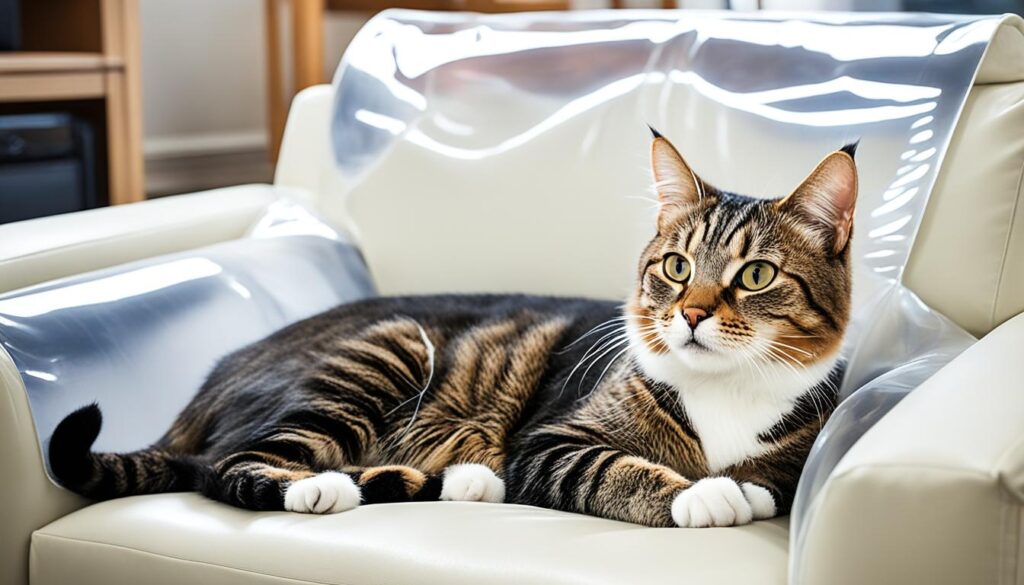
In conclusion, if you’re looking for a pet-proof furniture option that combines style and functionality, leather furniture is a top choice.
Its durability, resistance to pet stains and odors, and ease of maintenance make it a pet-friendly investment that can stand the test of time.
Say goodbye to worrying about scratches, spills, and pet-related messes, and say hello to a beautiful and pet-friendly home.
Furniture Materials and Pet-Proof Choices
When it comes to choosing furniture materials for a pet-friendly home, leather and microfiber are often the top considerations. Not only are they durable, but they also offer various advantages for pet owners.
Leather furniture, in particular, is a popular choice for pet owners due to its ease of cleaning and resistance to pet hair accumulation.
The smooth surface of leather makes it easier to remove pet fur with a simple wipe-down, unlike fabric couches that tend to trap it. Additionally, leather is less prone to staining and can withstand occasional pet accidents.
When selecting leather furniture, opt for high-quality grain leather, which is more durable and less likely to acquire scratches from your pets.
To further enhance its durability and longevity, consider applying a protective finish that acts as a barrier against potential pet damage.
Alongside leather, microfiber is another pet-friendly furniture material to consider.
Microfiber upholstery has tight woven fibers that discourage pet hair from sticking and can be easily cleaned with a vacuum or wipe. It is also resistant to stains and can withstand moderate scratching.
When choosing a pet-proof sofa, it’s essential to consider factors such as the specific needs and behaviors of your pets.
For example, if you have a cat that loves to scratch, opting for a leather sofa with a protective finish might be the best option to prevent unwanted marks.
Overall, both leather and microfiber offer excellent pet-friendly choices for your furniture. Consider your pets’ habits and preferences, as well as your own maintenance preferences, to make the best decision for your home.
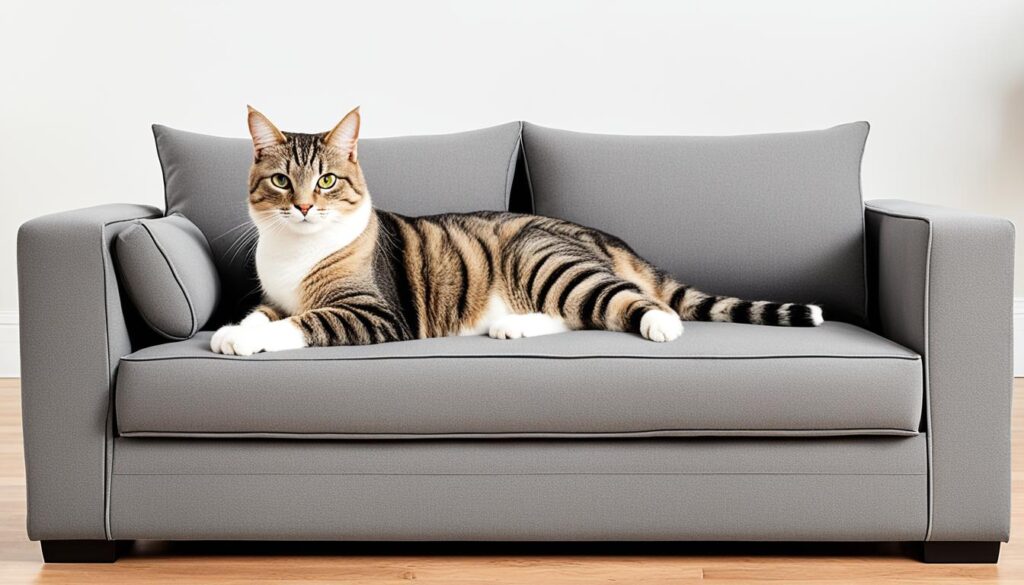
Training and Grooming Tips for Pet-Proofing Leather Furniture
When it comes to protecting your treasured leather furniture from your beloved pets, training and grooming are key.
By implementing a few simple strategies, you can ensure the longevity of your leather couch while keeping your furry friends happy and comfortable.
First and foremost, provide your pets with alternative scratching options. Invest in sturdy scratching posts and interactive toys that will divert their attention away from your leather couch.
Encourage them to use these designated scratching areas by rewarding them with praise and treats. This redirection of their natural instinct to scratch will help safeguard your leather furniture.
Another effective measure is to use throws and pet-friendly covers. These protective layers act as a barrier between your pets and your leather couch, preventing any potential stains or damage.
Opt for durable, machine-washable covers that are specifically designed to withstand the wear and tear of life with pets.
To further discourage your pets from lounging on your leather furniture, consider providing them with their own dedicated beds.
By offering a cozy and comfortable space for them to relax, you’ll be encouraging them to stay off your cherished couch.
Lastly, regular grooming is essential in maintaining the condition of both your pets and your leather furniture. Trim your cats’ nails regularly to minimize the risk of their scratching causing damage.
Additionally, brushing their fur is crucial in reducing shedding and preventing pet hair from becoming embedded in the leather.
If your cats’ scratching habit persists, or if you have concerns about their claws causing damage to your leather furniture, consider using Soft Paws/Claws.
These soft, vinyl caps can be applied to your cat’s claws to prevent them from scratching and causing harm. Although they require regular application and gentle handling during the initial stages, they can provide a humane alternative to declawing.
By combining these training and grooming tips, you can successfully pet-proof your leather furniture and enjoy a harmonious living space with your furry companions.
FAQs
How Can I Protect My Leather Couch From Cats?
There are several effective strategies to protect your leather couch from cats. Some tips include providing alternative scratching options, using throws and pet-friendly covers, and regularly grooming your pets.
Why Is Leather Furniture A Good Choice For Pet Owners?
Leather furniture, especially high-quality grain leather, is a popular choice for pet owners due to its durability. Leather is easier to clean, less likely to attract pet hair, and more resistant to pet odors compared to fabric couches.
What Are Some Pet-Proof Furniture Material Choices?
Leather and microfiber are commonly considered pet-proof choices for furniture. Leather, especially high-quality grain leather, is particularly suitable for pet owners due to its easy cleaning and resistance to pet hair.
How Can I Train And Groom My Pets To Protect My Leather Furniture?
To protect your leather furniture, provide your pets with alternative scratching options, such as scratching posts and toys. Use throws and pet-friendly covers to prevent stains on your leather couch.
Consider getting a separate bed for your pets to discourage them from jumping on the furniture. Regularly groom your pets by trimming their nails and brushing their fur.
Soft Paws/Claws can be a suitable alternative to declawing, providing regular application and gentle handling during the initial stages.
